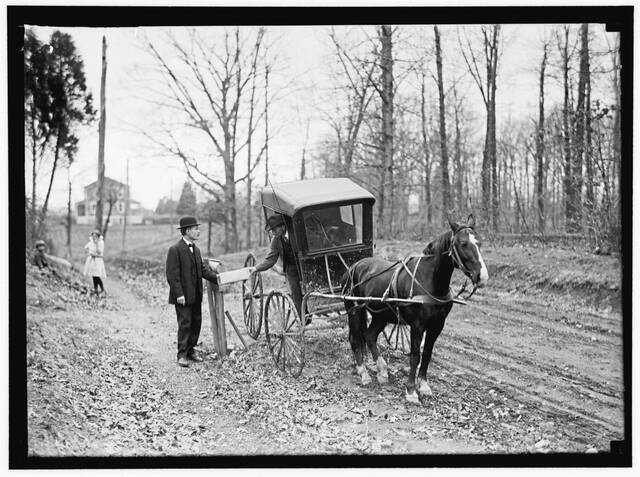For the last year, Bud Martin of Hempfield has used the U.S. Post Office in New Stanton as a regular mail service stop to avoid the traffic quagmire caused by ongoing construction in Youngwood.
On a recent stop, Martin, 41, readily confessed that he “never noticed” a state historical marker standing just a few steps from where he parks his car at the post office on West Pennsylvania Avenue. The sign recognizes the New Stanton and Ruffs Dale post office roles in the start of the country’s rural free delivery mail service that everyone takes for granted today.
Martin was not alone. Several other regular post office customers also admitted they regularly pass the marker but have not paid attention to the subject over the years.
“Wow. That’s pretty impressive, though. I never knew that before,” Martin said after reading the marker dedicated in 2001 by the Pennsylvania Historical and Museum Commission.
Nov. 24 will mark 125 years since residents in New Stanton and “Ruffsdale” — as it was spelled in the 19th century, according to state historians — made their mark in U.S. Postal Service history.
Lisa C. Hays, executive director of the Westmoreland Historical Society, noted the effort to expand free mail delivery service to rural communities was fought over many years in the 19th century.
“Free rural delivery by the post office simply provided a service to rural folks that was already available to those living in cities. Agricultural organizations promoted the idea to improve communication within rural communities,” she said.
And it was a fight that spanned years, according to a brief history of the marker on ExplorePAhistory.com.
“To receive their mail, farmers had to go into town to get it. It wasn’t easy for farmers to get to town, for there was always plenty of work to do and roads were often poor. A trip to town could take a half-day or more, so farmers often waited a few weeks or even longer to pick up their mail,” according to the website.
In January 1892, Congressman James O’Donnell of Michigan introduced “A Bill to Extend the Free Delivery System of Mails to Rural Communities,” but the House Committee on Post Office and Post Roads balked at the proposed $6 million price tag. An amendment bringing the figure down to $100,000 also was rejected.
On March 3, 1893, a bill introduced by one-term Georgia Congressman Tom Watson passed. It appropriated $10,000 for experimental rural free delivery, according to U.S. Postal service history archives. That proposal never got off the ground, either.
It wasn’t until William L. Wilson of West Virginia became Post Master General that he pushed forward with “an experiment” with $10,000 appropriated by Congress in 1896.
On October 1, 1896, rural free delivery (RFD) service first began in Charles Town, Halltown and Uvilla in West Virginia. Just over a month later, on Nov. 24, 1896, routes were added in New Stanton and Ruffsdale.
According to post office records, another route was added in Lancaster on Dec. 21, 1896. Within a year, 44 routes were operating in 29 states.
The state historical marker in New Stanton states: “On Nov. 24, 1896, the U.S. Post Office Department established Pennsylvania’s first two rural mail routes here in Westmoreland County. One operated here in New Stanton, the other operated out of nearby Ruffsdale (later spelled Ruffs Dale). The nation’s first five rural carriers started out the month before in West Virginia, and by 1905 the U.S. had 32,000 routes. They proved instrumental in breaking down rural isolation.”
Hays said area residents could compare the impact in the 19th century communications to current efforts to remove barriers in many rural areas.
“It is similar, perhaps, to trying to get universal internet service to less populated areas today, although that is not free,” she said.




